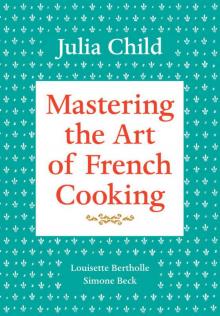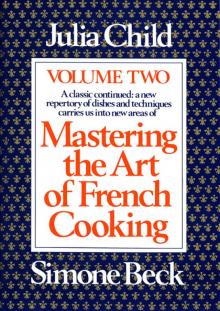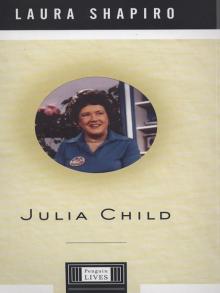- Home
- Julia Child
Laura Shapiro Page 7
Laura Shapiro Read online
Page 7
The division of labor was clear from the start: Simca’s job was to be French, and Julia’s was to be American. Simca had no trouble with this assignment: her recipes and all her experience in the kitchen flowed from the culture in which she grew up. She had French cooking, as Avis put it, “in her blood and bones.” Many of her recipes were original, but they were all outcroppings from the culinary tradition she had inherited and tended with care. To stand back and scrutinize the tradition objectively did not come easily to her: it was like trying to diagram the flavor of apples.
Julia, by contrast, was an American by temperament as well as birth who heartily believed in the scientific approach. To her, French culinary tradition was a frontier, not a religion, and the evidence of things unseen was no evidence at all. Although her favorite cookbook from home was Joy of Cooking, Julia had in her more than a touch of Fannie Farmer—the dedicated, charismatic cooking teacher who introduced level measurements in the late nineteenth century because her students wanted to know what “a pinch” of salt was, and how much flour was meant by “a handful.” Like Miss Farmer, who was a leader in the moral and culinary reform movement known as scientific cookery, Julia saw a higher realm waiting for those who mastered the skills of the kitchen; and she shared Miss Farmer’s certainty that painstaking methods and precise instructions had the power to transform both the cooking and the cook. To be sure, Julia’s vision of a higher realm was one rampant with pleasure, conviviality, and the free play of the senses. This was hardly what the pious founders of scientific cookery had in mind for their students and followers, whose lessons sometimes culminated in an all-white dinner evoking a temple of purity. But Julia believed as they did that good cooking was pragmatic cooking, a matter of forming the right habits and using them daily—a discipline, not a burst of inspiration. One day she took a piece of notepaper and wrote “A good cook” at the top of it. Then she jotted down a definition: “is consistently good—not just a little flair here & there—She can turn out a good meal either simple or complicated, can adapt herself to conditions, and has enough exp. to change a failure into a success. If the fish doesn’t moose [mousse]—it becomes a soup. Matter of practice & passion.” Practice and passion: Julia put them together and kept them there in all her teaching and writing, twin imperatives that were useless when separated.
During the years that she and Simca were working on the book, they rarely inhabited the same kitchen. Paul was posted to Marseille in 1954, then to Bonn, then back home to Washington, and finally to Oslo before retiring in 1961. Although the two women were able to visit each other occasionally for marathon cooking sessions, most of their discussions and fights were carried on by letter. Recipes, notes, suggestions, additions, revisions, and corrections flew back and forth, sometimes in quantities that would have merited a doctoral degree in any other discipline. When Julia launched an assault on cassoulet—a rich and hefty assortment of beans, meats, and sausages that could take up to three days to prepare—she first rounded up twenty-eight recipes, all authentic from reputable sources, many of them contradictory. She and Simca winnowed them down, combining and refining and rewriting until they reached a single, triumphant version, all the while carrying on a blazing argument about preserved goose. Few American households were likely to have access to preserved goose, but Simca insisted it was essential: without it, they couldn’t call the dish cassoulet. Mutton stew, perhaps. But not cassoulet. Julia pounded her with source after source that omitted preserved goose. At length Julia won, though the two families ate many more cassoulets than anyone wished before a truce was declared.
Other recipes were simpler, but everything required numerous tweaks and tinkerings before both women were satisfied. Working on spinach, Julia picked up an idea from a book and dashed off a note in the scramble of French and English with which she always wrote to Simca. “Suggestion which comes from A. Suzanne, a contemporary of Escoffier, which is to put une pointe d’ail in les epinards, especially ‘au jus,’ and even à la crème. So small it is hardly noticeable, it does a certain amount of relevement which is very agreeable. Please try.” Every nuance counted; every minor shift in method had to be recorded. “I want every detail from you that you can think of,” Julia begged. “Whether or not I use the detail is of no matter, I want it anyway. People must say of this book, A MARVELOUS BOOK. I’ve never been able to make cake before, but now I can.”
This imagined reader, the desperate homemaker who couldn’t cook until the right book fell into her hands, had a permanent place in Julia’s consciousness and directly inspired the immense amount of detail that characterized her recipes. Like a ghost from Julia’s own past, she trailed Julia from kitchen to desk and back again, forever trying to figure out whether the roast was done, why the chops were steaming in the pan instead of browning properly, what made the cream puffs soggy, and exactly how thick the beef slices should be: a quarter inch? an eighth of an inch? Julia often called her “the young bride.” Simca, of course, had no such creature haunting her—she had been a young bride who cooked splendidly from the first day—and Julia had to plead with her to measure and test with scientific rigor. Take nothing for granted, she counseled Simca over and over. Don’t ever make a statement of fact until it has been tested so many times we “absolutely know” it is true. She sent Simca a meat thermometer and measuring cups, and issued constant bulletins on her own experiments. “I have just poached two more eggs,” she reported from deep within the egg chapter. “Well, the eggs weighed 60 grams or two ounces, and they do, effectivement, need 4 minutes. I also found, measuring everything again, that there should be but 1½ to 2 inches water, and the pan should be but 8 inches in diameter. Thank heaven I did it again to catch these two awful errors.” Simca had a hard time keeping up with this degree of microscopic fussing, and as she moved from recipe to recipe, she kept forgetting to use the methods they had worked out so exhaustively.
Simca was an extraordinary cook, and Julia knew it, but the recipes Simca contributed from her own repertoire were far too personal to go into the book without extensive testing and revision. Not only did they need to be made scientifically precise, but Julia wanted to be sure they represented the mainstream of French tradition. What horrified Julia about many French cookbooks, especially the ones written by Americans, was that the authors seemed to feel they were free to rewrite standard recipes in any fashion they chose, and then present the result as completely classic. She was frantic with worry that the recipes she received from Simca had been Simca-fied, made delicious in Simca’s hands but allowed to wander significantly off course. “It is not, my dear, that I do not have confidence in you!” she insisted in the course of a quarrel about clafoutis. “I think we are both interested, in this book, in making sure it is La Veritable Cuisine Française, and not just La Cuisine Simca/ Julia.” The book would have to depart from tradition at times, for instance when certain ingredients weren’t available in America, but Julia was adamant that whenever she and Simca altered a template, they had to say so up front. Once, when they were working together in Marseille on sauce à la rouille, Simca casually referred to the recipe they had developed as “Rouille Julia”—idiosyncratic, that is, and not traditional. Julia was aghast. “That is a SHOCKING remark coming from you,” she wrote after the visit. “It means that you have allowed me to perpetrate a little ‘popote Julia’ into a book on French cooking.” Simca’s role, Julia reminded her, was to protect the authenticity of the recipes, even and especially from Julia herself. The most crucial piece of equipment they had was Simca’s taste memory.
Simca would have been happy to rely on her own palate for the book she and Louisette had originally planned, but this book had far loftier aspirations, and they made her nervous. She and Julia were only a couple of home cooks, and women at that. How dare they contradict, in print, the old masters and professional chefs who constituted the priestly class in French cooking? The sight of the recipes she and Julia had worked so hard on, all typed up and ready for the publis
her, filled her with anxiety. Often she demanded they go back and make changes in a recipe completed long ago, just because she’d come across a chef who had a different method—surely he knew better than the two of them. This stubborn diffidence made Julia impatient. “I consider ourselves just as much AUTHORITIES as anyone else,” she railed. What did the sages have that she and Simca lacked? The two women had training and experience, they consulted the sources, they did a vast amount of cooking, tasting, and testing. But the confidence Julia sported so comfortably was foreign to Simca. Though she could fight fiercely, she had a streak of what Julia called “obéissance,” or “obedience”—an instinct Julia thought was typical of Frenchwomen who tended to defer to men far too readily. A year and a half into their collaboration, Julia sent Simca—“Ma plusque chère Colleague”—three rules to live by:
Stand up for your opinions as an equal partner in this enterprise.
Keep the book French.
Follow the scientific method, respecting your own careful findings, after having studied the findings and recommendations of other authorities. Work with exact measurements, temperatures, etc. And, once having established a method, stick to it religiously unless you find it is not satisfactory.
(Then she tossed in a postscript: “Please, also, learn to cut professionally with a knife. Who knows, we may end up on television, and you must establish professional techniques.”)
For Julia, the moral barometer for this project was not fidelity to the old masters but fidelity to the food. Those first months in France, when she spent day after day plunging into flavors of an intensity she had never known before, had left a permanent stain on her senses. To have lived so long without this! Now she was determined to re-create that food by writing recipes so precise, so perfect, that each was a miniature version of the discovery that had transformed her. She was on a quest for le gout français—the very flavor of Frenchness. Like any flavor, this one was hard to describe in words, but instantly recognizable on the palate. Julia never doubted for a moment that the quintessential taste of France was portable, that it could be realized by any cook, anywhere, with the right instructions. She and Simca were going to capture that taste, press it like a butterfly onto every page of their book. And unlike Simca, she knew she would have no qualms about claiming victory. This was cooking, not alchemy; the only secrets were spread out on the kitchen counter for all to see: butter and eggs and string beans, whisks and saucepans and measuring spoons. Nothing mysterious, nothing unquantifiable. “If one is using French methods and French ingredients or as near an equivalent as can be found, one achieves GOUT FRANÇAIS,” she said flatly.
The moment she used the term French ingredients, of course, she had to qualify it. Many of the ingredients that Americans would have to use would be “as near an equivalent as can be found,” and some of them wouldn’t be all that near. But Julia was never the sort of gastronome who thought great cooking began and ended with perfect ingredients; she was far too pragmatic for that. It’s not that she was immune to their splendor: like every other American eating in Paris for the first time, she had been dazzled by the startlingly bright flavors of the fresh fruits and vegetables. “Strawberries, for instance, are dreamberries,” she wrote to Avis. “Beans are so deliciously beany. They haven’t yet gotten on to the system of growing a tough variety that will keep well in the markets.” Yet she quite forgot to include in the manuscript any mention of how important it was to use the best possible ingredients; and when she remembered, about a year before the book was published, she merely shrugged. Other errors in the manuscript—or worse, the index—dismayed her terribly, but not this one. It was far more important that the book fend off the popular assumption that every food item in France was superior to its American counterpart. Too many tourists came to Paris, swooned over the food, and went home convinced that meals so glorious must spring from wondrous ingredients unique to France. Not true, Julia insisted. Spinach was spinach, and even if it wasn’t, good cooking would make up for the difference.
Julia was so obsessively open-minded on the subject of American ingredients that she wouldn’t even exclude canned and frozen products, at least not without giving them a chance to prove themselves. French gastronomes thought packaged foods were barbaric, and sophisticated Americans were embarrassed by them, but Julia wanted her recipes to be within reach of every home cook who could summon the ambition to try them. If a box of frozen peas, or a can of bouillon, honestly merited a place in a traditional French recipe, the book should say so. There was nothing to be gained by snobbery. She shopped for such products at the embassy commissary and devoted long testing sessions to them, generally with grim results. “I have just served my poor husband the most miserable lunch of frozen haddock Dugléré, frozen ‘fresh’ string beans and ‘minute’ rice,” she wrote to Avis after an early effort in 1953. “It is just no fun to eat that stuff, no matter how many French touches and methods you put to it. It ain’t French, it ain’t good, and the hell with it.”
That afternoon, Julia went out for a restorative walk along one of her favorite streets, rue de Seine, and came home in a better mood. But she wasn’t going to quit: she would continue experimenting even though by their very nature these products threw a wet blanket over the kitchen. Where was the tactile pleasure of handling food, where were the smells, and where oh where were the flavors? “Got a frozen roasting chicken the other day,” she reported to Avis. “It was mushy, a bit chewy, and had very little taste. It had, also, a slightly rancid-fat overtone.” She tried warming half of it in a coq au vin sauce, which lent a little flavor but not enough to salvage the product or win it a mention in the book. “If things aint good, they aint; we are not in the frozen food lobby.” To her astonishment, instant potatoes turned out to be pretty good, though requiring quite a bit of butter, cream, and cheese. Uncle Ben’s Converted Brand Rice became such a favorite she took to calling it “l’Oncle Ben’s,” and she was so delighted with instant piecrust mix that she sent a box to Simca and told her she must try it. Simca was not impressed: she disliked the taste of vegetable shortening in place of butter. Julia admitted the flavor wasn’t really French. “However, they certainly are easy and certainly perfectly good. And certainly better for that average housewife, French or US, who would otherwise make a horrid crust,” she argued.
In a way, she was arguing with herself more than with Simca. At the time she tried piecrust mix, she was living in Washington, D.C., and taking careful note of how Americans behaved in the kitchen. So many of them lacked basic skills or were reluctant to take the time to do things well. Was the point of the book to get better-tasting food on the American table, by any means necessary? Or was the pur pose to make real changes, to move wonderful food to the center of American life? One day she was working on glacéed carrots and onions and decided to save time by using canned onions. The result was so awful she shot off a letter to Simca. “I DO NOT LIKE CANNED ONIONS AT ALL,” she announced. “I suggest that we say: WE DO NOT LIKE CANNED ONIONS. Period.” The incessant American preoccupation with saving time was getting on her nerves. “I think we cannot compromise on the techniques of making things taste the way they should taste even if some refusals to take the easy way result in some time-consuming operations,” she decided. “Our book is on how to make things taste the way they should.” In the end, piecrust mixes did not get into the pastry chapter.
But in other respects, the two years in Washington were revelatory. Supermarkets she found to be a splendid innovation: she loved pushing her cart through the aisles and getting a good view and feel of everything on display. Unlike a charming little French market, where the shopkeeper picked out the items for each customer, these huge, impersonal stores left her free to select exactly the mushrooms she wanted, the very bunch of parsley that looked best to her. “It is so heavenly to go to the asparagus counter and pick out each individual spear yourself, or each single string bean,” she exclaimed to Simca. “The asparagus is perfectly delicious! This is the
season where they come by rapid transit from California, and are great fat green spears, sweet, tender and perfect.” Back in France she had been sure that if produce had to be shipped cross-country, there was no hope for flavor, but now she was eating fine springtime asparagus and doing so with delight.
At the same time, however, disappointments were piling up. Her quest for decent American chicken—whole or in parts, fresh or frozen, supermarket or butcher shop—went on for years. Butter, the most beloved ingredient in her kitchen, was tasteless compared with its French counterpart; and thick, matured cream with the nutty flavor of French cream was nowhere to be found. Shallots were expensive and rarely available; nobody would be able to buy a calf’s foot or a pig’s caul; the veal was inferior to French, and the only fresh herb in sight was parsley. What’s more, Americans had the irritating habit of not drinking wine. That was regrettable in itself, but if they didn’t drink wine regularly, they weren’t going to have it on hand for cooking, and wine was essential for flavor. Conceivably they might buy a bottle of inexpensive California red just for cooking, but the inexpensive California whites were dreadful, in Julia’s estimation. Avis wondered whether vermouth might be a substitute, since people tended to have it around for cocktails. Julia rejected the idea at first, because the “strong and herbal taste” would throw off the flavor of sauces. But after living in Washington for a while, she relented. “People just do not have bottles of white wine all the time to use in cooking,” she explained to Simca. “If they bought one for a bit of cooking, they wouldn’t know what to do with the rest of it. Therefore I think we must always specify the choice of White Vermouth, as everybody has that; and it will keep after having been opened.” She experimented with proportions and found that if she used vermouth more sparingly than wine in delicate sauces, the flavor was satisfactory.

 Julia's Kitchen Wisdom
Julia's Kitchen Wisdom My Life in France
My Life in France Mastering the Art of French Cooking, Volume 1
Mastering the Art of French Cooking, Volume 1 Mastering the Art of French Cooking, Volume 2
Mastering the Art of French Cooking, Volume 2 Laura Shapiro
Laura Shapiro